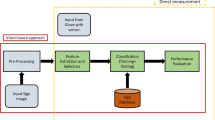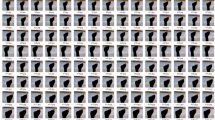Abstract
The deaf community faces some major challenges due to the communication gap with the hearing community. The traditional approach of employing a Sign Language (SL) interpreter is not an efficient and cost-effective solution to this problem. Thus, an automated Sign Language Recognition System (SLRS) is needed to provide an efficient and reliable solution. Existing SLRS for dynamic SL recognition utilizes the CNN-LSTM architecture, which has accomplished satisfactory results. However, spatial features extracted through Convolutional Neural Network (CNN) are insufficient for recognizing SL word that consists of identical hand orientation and multiple viewing angles. Thus, this paper proposes an SLRS named Automated Indian Sign Language Recognition System for Emergency Words (AISLRSEW) for recognizing ISL words which are frequently used in an emergency situation. The proposed AISLRSEW uses a combination of CNN and local handcrafted features to resolve the issue of identifying SL words with identical hand orientation and multiple viewing angles, which improves the recognition accuracy. The performance of the proposed AISLRSEW is evaluated with two fold cross-validation method and compared with existing models. The proposed model has achieved an average accuracy of 94.42%, which is comparatively better than existing models.










Similar content being viewed by others
Data availability
The authors declare that all data supporting the findings of this study are available within the article.
References
Adithya V, Reghunadhan R (2021) "Applying deep neural networks for the automatic recognition of sign language words: A communication aid to deaf agriculturists." Expert Syst Appl, pp-1-12
Aditya V, Rajesh R (2020) Hand gestures for emergency situations: A video dataset based on words from Indian sign language.Data in Brief 31. https://doi.org/10.1016/j.dib.2020.106016
Aly S, Aly W (2020) Deep ArSLR: A Novel Signer-Independent Deep Learning Framework for Isolated Arabic Sign Language Gestures Recognition. IEEE Access 8:83199–83212
Ansari MA, Singh DK (2019) An approach for human machine interaction using dynamic hand gesture recognition. In: 2019 IEEE Conference on Information and Communication Technology, pp 1–6. https://doi.org/10.1109/CICT48419.2019.9066173
Aparna C, Geetha M (2020) CNN and stacked LSTM model for Indian sign language recognition. Machine Learning and Metaheuristics Algorithms, and Applications, 126–134. https://doi.org/10.1007/978-981-15-4301-2_10
Athira PK, Sruthi CJ, Lijiya A (2019) Signer independent sign language recognition with co-articulation elimination from live videos: an indian scenario.Journal of King Saud University - Computer and Information Sciences 34(3):771–781.https://doi.org/10.1016/j.jksuci.2019.05.002
Bhatti UA, Huang M, Wang H, Zhang Y, Mehmood A, Di W (2018) Recommendation system for immunization coverage and monitoring. Hum Vaccin Immunother 14(1):165–171. https://doi.org/10.1080/21645515.2017.1379639
Bhatti UA, Huang M, Zhang DWY, Mehmood A, Han H (2019) Recommendation system using feature extraction and pattern recognition in clinical care systems. Enterp Inf Syst 13(3):329–351
Bhatti UA, Yu Z, Chanussot J, Zeeshan Z, Yuan L, Luo W, Nawaz SA, Bhatti MA, Ain QU, Mehmood A (2021) Local Similarity-Based Spatial–Spectral Fusion Hyperspectral Image Classification with Deep CNN and Gabor Filtering. IEEE Trans Geosci Remote Sens Volume: 60:1–15
Bhatti UA, Zeeshan Z, Nizamani MM, Bazai S, Yu Z, Yuan L (2022) Assessing the change of ambient air quality patterns in Jiangsu Province of China pre-to post-COVID-19. Chemosphere 288(Pt 2):132569. https://doi.org/10.1016/j.chemosphere.2021.132569
Breland SD, Skriubakken SB, Dayal A, Jha A, Yalavarthy PK (2021) Deep Learning-Based Sign Language Digits Recognition from Thermal Images with Edge Computing System. IEEE Sens J 21(9):10445–10453
Cai Y et al (2021) YOLOv4-5D: An Effective and Efficient Object Detector for Autonomous Driving. IEEE Trans Instrum Meas 70:1–13. https://doi.org/10.1109/TIM.2021.3065438
Chowdhary CL, Patel PV, Kathrotia KJ, Perumal MAK, Ijaz MF (2020) Analytical study of hybrid techniques for image encryption and decryption. Sensors 20(18):5162
Das S, Biswas SK, Chakaraborty M, Purkayastha B (2022) “A Review on Sign Language Recognition (SLR) System: ML and DL for SLR”, IEEE Int Conf Intell Syst, Smart Green Technol (ICISSGT), pp. 177–182
Das S Das S, Biswas SK, Chakaraborty M, Purkayastha B (2022) “Intelligent Indian Sign Language Recognition Systems: A Critical Review”, ICT Syst Sustain, pp. 703–713
Dhingra, N, Kunz, A (2019) Res3atn - deep 3D residual attention network for hand gesture recognition in videos. In 2019 international conference on 3D vision (3DV) (pp. 491–501)
Dutta KK, Bellary S (2017) “Machine Learning Techniques for Indian Sign Language Recognition”, Int Conf Current Trends Comput Electr Electron Commun (ICCTCEEC), pp. 333–336
Fang Y, Liu J, Li J, Cheng J, Hu J, Yi D, Xiao X, Bhatti UA (2022) Robust zero-watermarking algorithm for medical images based on SIFT and Bandelet-DCT. Multimed Tools Appl 81(12):16863–16879
Gupta B, Shukla P, Mittal A (2016) “K-nearest correlated neighbor classification for Indian sign language gesture recognition using feature fusion”, in International Conference on Computer Communication and Informatics (ICCCI)
Hoang, NN, Lee, G-S, Kim, S-H, Yang, H-J (2018) A real-time multimodal hand gesture recognition via 3D convolutional neural network and key frame extraction. In proceedings of the 2018 international conference on machine learning and machine intelligence (pp. 32–37)
Hore S, Chatterjee S, Santhi V , Dey N, Ashour AS, Balas V, Shi F (2017) “Indian Sign Language Recognition Using Optimized Neural Networks”, Inf Technol Intell Transport Syst, pp. 553–563
Hussain R, Karbhari Y, Ijaz MF, Woźniak M, Singh PK, Sarkar R (2021) Revise-net: exploiting reverse attention mechanism for salient object detection. Remote Sens 13(23):4941
Ismail MH, Dawwd SA, Ali FH (2022) Dynamic hand gesture recognition of Arabic sign language by using deep convolutional neural networks. Ind J Electr Eng Comput Sci 25(2):952–962
Janani T, Ramanan A (2017) Feature Fusion for Efficient Object Classification Using Deep and Shallow Learning. Int J Mach Learn Comput 7(5):123–127
Jayadeep G, Vishnupriya NV, Venugopal V, Vishnu S, Geetha M (2020) Mudra: convolutional neural network based indian sign language translator for banks. In: 2020 4th International Conference on Intelligent Computing and Control Systems (ICICCS), pp 1228–1232. https://doi.org/10.1109/ICICCS48265.2020.9121144
Kaur P, Kumar Y, Ahmed S, Alhumam A, Singla R et al (2022) Automatic license plate recognition system for vehicles using a cnn. Comput Mater Contin 71(1):35–50. https://doi.org/10.32604/cmc.2022.017681
Tareen SAK, Saleem Z (2018) A comparative analysis of SIFT, SURF, KAZE, AKAZE, ORB, and BRISK. In: 2018 International Conference on Computing, Mathematics and Engineering Technologies (iCoMET), pp 1–10. https://doi.org/10.1109/ICOMET.2018.8346440
Kumar NKS, Malarvizhi N (2020) Bi-directional LSTM–CNN combined method for sentiment analysis in part of speech tagging (PoS). Int J Speech Technol 23(373–380)
Kumar P, Gauba H, Roy PP, Dogra DP (2017) A multimodal framework for sensor based sign language recognition.Neurocomputing 259:21–38. https://doi.org/10.1016/j.neucom.2016.08.132
Alzubaidi L et al (2021) Review of deep learning: concepts, CNN architectures, challenges, applications, future directions. J Big Data 8:53. https://doi.org/10.1186/s40537-021-00444-8
Li Y, Cai Y, Malekian R, Wang H, Sotelo MA, Li Z (2021) Creating navigation map in semi-open scenarios for intelligent vehicle localization using multi-sensor fusion. Exp Syst Appl Volume: 184:1–12
Li T, Li J, Liu J, Huang M, Chen YW, Bhatti UA (2022) Robust watermarking algorithm for medical images based on log-polar transform. EURASIP J Wireless Commun Netw Volume: 24:1–11
Likhar P, Bhagat NK, Rathna GN (2020) “Deep learning methods for Indian sign language recognition”,10th International Conference on Consumer Electronics (ICCE-Berlin)
Lowe DG (2004) Distinctive image features from scale-invariant keypoints. Int J Comput Vis 60:91–110. https://doi.org/10.1023/B:VISI.0000029664.99615.94
Mittal A, Kumar P, Roy PP, Balasubramanian R, Chaudhuri BB (2019) A modified-LSTM model for continuous sign language recognition using leap motion. IEEE Sens J 19(16):1–8
Nanni L, Ghidoni S, Brahnam S (2017) Handcrafted vs. non-handcrafted features for computer vision classification,Pattern Recogn 71:158–172.https://doi.org/10.1016/j.patcog.2017.05.025
Nawaz SA, Li J, Bhatti UA, Bazai SU, Zafar A, Bhatti MA, Mehmood A, Ain Q, Shoukat MU (2021) A hybrid approach to forecast the COVID-19 epidemic trend. Plos One 16(10):1–16
Rastgoo R, Kiani K, Escalera S (2020) Hand sign language recognition using multi-view hand skeleton. Expert Syst Appl 150:113336.https://doi.org/10.1016/j.eswa.2020.113336
Rastgoo R, Kiani K, Escalera S (2021) Sign language recognition: a deep survey. Expert Syst Appl 164:113794.https://doi.org/10.1016/j.eswa.2020.113794
Rastgoo R, Kiani K, Escalera S (2021) Sign language recognition: a deep survey. Expert Syst Appl, [ISSN: 0957-4174] 164(113794):1–27
Saraee E, Jalal M, Betke M (2020) Visual complexity analysis using deep intermediate-layer features. Comput Vis Image Underst 195:1–17
Shaik KB, Ganesan P, Kalist V, Sathish BS, Jenitha JM (2015) “Comparative Study of Skin Color Detection and Segmentation in HSV and YCbCr Color Space”, Int Conf Recent Trends Computing (ICRTC), pp.41–48
Singh DK (2021) “3D-CNN based Dynamic Gesture Recognition for Indian Sign Language Modeling”, Int Conf AI Comput Linguist, pp. 76–83
Sonare B, Padgal A, Gaikwad Y, Patil A (2021) “Video-Based Sign Language Translation System Using Machine Learning”, 2nd International Conference for Emerging Technology (INCET), pp. 1–4
Sridhar A, Ganesan RG, Kumar P, Khapra M (2020) INCLUDE: A Large Scale Dataset for Indian Sign Language Recognition. In: Proceedings of the 28th ACM International Conference on Multimedia. Association for Computing Machinery, Seattle, pp 1366–1375. https://doi.org/10.1145/3394171.3413528
Tamang J, Nkapkop JDD, Ijaz MF, Prasad PK, Tsafack N, Saha A, Kengne J, Son Y (2021) Dynamical properties of ion-acoustic waves in space plasma and its application to image encryption. IEEE Access Volume:9:18762–18782
Taskiran M, Killioglu M, Kahraman N (2018) A real-time system for recognition of american sign language by using deep learning. In: 2018 41st International Conference on Telecommunications and Signal Processing (TSP), pp 1–5. https://doi.org/10.1109/TSP.2018.8441304
Venugopalan A, Reghunadhan R (2021) Applying deep neural networks for the automatic recognition of sign language words: A communication aid to deaf agriculturists. Expert Syst Appl Volume 185:1–9
Wadhawan A, Kumar P (2020) Deep learning-based sign language recognition system for static signs. Neural Comput Appl Volume 32:7957–7968
Zhang E, Botao X, Fangzhou C, Jinghong D, Guangfeng L, Yifei L (2019) Fusion of 2D CNN and 3D densenet for dynamic gesture recognition. Electron 8(1511):1–15
Funding
The authors have no relevant financial or non-financial interests to disclose.
Author information
Authors and Affiliations
Corresponding author
Ethics declarations
Competing interests
The authors have no competing interests to declare that are relevant to the content of this article.
Additional information
Publisher’s note
Springer Nature remains neutral with regard to jurisdictional claims in published maps and institutional affiliations.
Rights and permissions
Springer Nature or its licensor (e.g. a society or other partner) holds exclusive rights to this article under a publishing agreement with the author(s) or other rightsholder(s); author self-archiving of the accepted manuscript version of this article is solely governed by the terms of such publishing agreement and applicable law.
About this article
Cite this article
Das, S., Biswas, S.K. & Purkayastha, B. Automated Indian sign language recognition system by fusing deep and handcrafted feature. Multimed Tools Appl 82, 16905–16927 (2023). https://doi.org/10.1007/s11042-022-14084-4
Received:
Revised:
Accepted:
Published:
Issue Date:
DOI: https://doi.org/10.1007/s11042-022-14084-4




